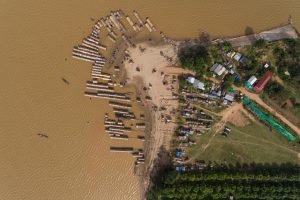On December 11, Cambodian Prime Minister Hun Manet met with his Vietnamese counterpart Pham Minh Chinh on an official visit to Vietnam’s capital Hanoi. During the two-day visit, the two sides engaged in discussions over such issues as defense, border affairs, trade, and education. They also signed cooperation agreements in the fields of science and trade.
During his talks with Manet, Chinh expressed his concern over Cambodia’s Funan Techo Canal project. He was worried that the project would negatively affect the environment and the water system of the Mekong River, especially the downstream water flow from Cambodia to Vietnam. In response, Hun Manet reassured him that the preliminary studies on the project indicated that the environmental impacts on Vietnam would be minimal.
The Funan Techo project, estimated to cost around $1.7 billion, is an artificial canal that will connect Cambodia’s seaports in the southwest to the Mekong River. The 180-kilometer-long canal will connect the coastal province of Kep to the existing Takeo Canal of the Mekong River via a system of lock gates. This will essentially create a waterway linking the capital Phnom Penh to the coast and more importantly the country’s only deep-sea port at Sihanoukville. This mega project is among the priority infrastructure projects promulgated by Hun Manet’s government since it took office in August. A feasibility study for the project has now been completed and the Cambodian government estimates that it will take four years to complete. If successful, it will reduce the cost of hauling goods from the deep-sea port to the capital and vice-versa.
Chinh’s expressed concerns were viewed negatively by many Cambodian commentators and political figures, who claimed that his concern was not genuine and was more political-economic than environmental. The Khmer-language broadcaster Radio France Internationale quoted some Cambodian political and social commentators as saying that Vietnam was unhappy with Cambodia for pushing ahead with the project. Channeling old fears of Vietnam’s undue influence over Hun Manet’s Cambodian People’s Party, some suggested that Cambodia, as Vietnam’s “client state,” needed to inform and “appease” its patron Vietnam by informing it about every step of the plan. Another commentator went as far as to suggest that Vietnam was worried that China might use this canal to advance its military ambitions in the region.
Contrary to these claims, the reality is more mundane: Vietnam’s concern over Cambodia’s mega canal project is mostly economic in nature. For one thing, it is possible that the project could cause downstream environmental issues for Vietnam, affecting fisheries and agriculture in the Mekong Delta. For another, the Funan Techo Canal will reduce Cambodia’s dependence on Vietnam for maritime transportation. In 2016, the Japan International Cooperation Agency published a report revealing that Phnom Penh relies on Vietnam’s ports for transporting its garment exports and raw material imports.
Cambodia has two important ports: Sihanoukville Autonomous Port in the southwest and the Phnom Penh Autonomous Port on the Mekong River. The two ports link via National Road 4 (and the newly constructed Expressway E4) and the dilapidated southwest rail line. However, there is no waterway connecting the two ports, and currently, goods must be transported from Phnom Penh to Sihanoukville Autonomous Port and vice-versa by road and rail, which are costly and slow. That is where Vietnam comes in. Phnom Penh is home to half of the factories in Cambodia’s garment sector – its most important manufacturing sector.
The city has a waterway connection to Vietnam’s ports via the Mekong River. Thus, the garment exports are usually shipped on motorized barges from Phnom Penh Autonomous Port to ports around Ho Chi Minh City (usually Cat Lai Port and Cai Mep Port). The same applies to Phnom Penh’s imports of raw materials for its garment industry. It is cheaper to ship goods via Vietnam to Phnom Penh than it is to transport them via rail or road from Sihanoukville.
The shipment between Cambodia and Vietnam via the Mekong River and its tributaries was facilitated by the Treaty on Waterway Transportation, which the two nations signed in 2009, and which granted each other’s vessels the “most favored nation” status. This has streamlined immigration and customs procedures; it has also deepened Cambodia’s economic dependence on Vietnam.
The Funan Techo Canal will basically close the missing link between Phnom Penh and the Sihanoukville Autonomous Port. This will allow for the easy transport of goods between the two ports in Phnom Penh and Sihanoukville, and reduce Cambodia’s reliance on Vietnamese ports. This is what Prime Minister Hun Manet has recently referred to as “breathing through our own nose.” When the Funan Techo Canal is finished, Vietnam will certainly lose the economic gain and influence it has enjoyed – and this is most likely explains the Vietnamese prime minister’s concerns.

































